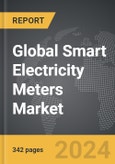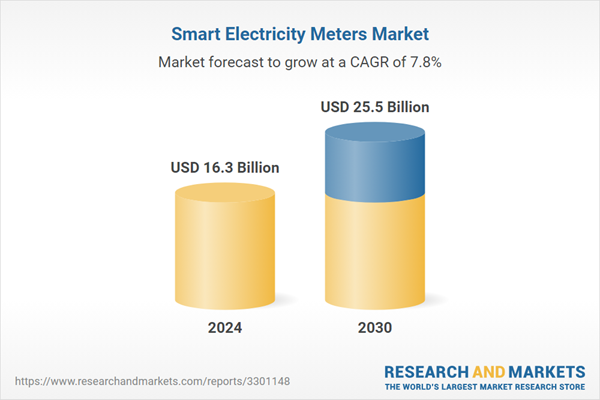The global market for Smart Electricity Meters was valued at US$16.3 Billion in 2024 and is projected to reach US$25.5 Billion by 2030, growing at a CAGR of 7.8% from 2024 to 2030. This comprehensive report provides an in-depth analysis of market trends, drivers, and forecasts, helping you make informed business decisions. The report includes the most recent global tariff developments and how they impact the Smart Electricity Meters market.
The adoption of smart electricity meters has been significantly influenced by technological advancements and the growing demand for energy efficiency. Modern smart meters are equipped with features such as remote connect/disconnect capabilities, tamper detection, and integration with home energy management systems. The granular data provided by these meters enables utilities to implement demand response programs, which incentivize consumers to reduce or shift their energy usage during peak periods. Additionally, smart meters facilitate more accurate billing and reduce operational costs associated with manual meter readings and billing disputes. The integration of smart meters with renewable energy sources, like solar and wind, enhances grid stability by allowing for better management of distributed energy resources. Furthermore, smart meters support the development of microgrids and localized energy solutions, fostering greater resilience and sustainability in energy systems.
The growth in the smart electricity meters market is driven by several factors, including regulatory mandates, technological advancements, and increasing consumer awareness. Governments worldwide are implementing policies to promote the adoption of smart meters as part of broader initiatives to modernize electrical grids and improve energy efficiency. In the United States, various state-level programs and federal incentives encourage the widespread adoption of smart metering technology. Advancements particularly in the Internet of Things (IoT) and communication technologies, have made smart meters more reliable, secure, and cost-effective, prompting utilities to invest in smart metering infrastructure. Additionally, rising consumer awareness about energy conservation and the benefits of real-time energy usage data has driven demand for smart meters. Consumers are increasingly looking for ways to manage their energy consumption more efficiently to reduce costs and minimize their environmental impact. These factors collectively underscore the dynamic growth of the smart electricity meters market, highlighting its crucial role in the transition towards smarter, more sustainable energy systems.
Segments: Phase (Single-Phase, Three-Phase); Technology (Automatic Meter Reading (AMR), Advanced Metering Infrastructure (AMI)); End-Use (Residential, Commercial, Industrial).
Geographic Regions/Countries: World; USA; Canada; Japan; China; Europe; France; Italy; UK; Rest of Europe; Asia-Pacific; Rest of World.
The analysts continuously track trade developments worldwide, drawing insights from leading global economists and over 200 industry and policy institutions, including think tanks, trade organizations, and national economic advisory bodies. This intelligence is integrated into forecasting models to provide timely, data-driven analysis of emerging risks and opportunities.
Global Smart Electricity Meters Market - Key Trends & Drivers Summarized
Smart electricity meters, integral components of modern smart grids, are advanced devices designed to provide real-time monitoring and management of electrical energy consumption. Unlike traditional meters, which require manual readings and offer limited usage information, smart meters deliver detailed, timely data on electricity consumption patterns. These meters utilize advanced communication technologies such as wireless networks, power line communication, or cellular networks to enable two-way communication between the meter and the utility provider. This capability allows for dynamic pricing, peak load management, and rapid detection of outages, ultimately contributing to a more reliable and efficient energy distribution system. By providing utilities with detailed insights into consumption trends, smart meters help optimize energy distribution, reduce losses, and enhance the overall stability of the power grid.The adoption of smart electricity meters has been significantly influenced by technological advancements and the growing demand for energy efficiency. Modern smart meters are equipped with features such as remote connect/disconnect capabilities, tamper detection, and integration with home energy management systems. The granular data provided by these meters enables utilities to implement demand response programs, which incentivize consumers to reduce or shift their energy usage during peak periods. Additionally, smart meters facilitate more accurate billing and reduce operational costs associated with manual meter readings and billing disputes. The integration of smart meters with renewable energy sources, like solar and wind, enhances grid stability by allowing for better management of distributed energy resources. Furthermore, smart meters support the development of microgrids and localized energy solutions, fostering greater resilience and sustainability in energy systems.
The growth in the smart electricity meters market is driven by several factors, including regulatory mandates, technological advancements, and increasing consumer awareness. Governments worldwide are implementing policies to promote the adoption of smart meters as part of broader initiatives to modernize electrical grids and improve energy efficiency. In the United States, various state-level programs and federal incentives encourage the widespread adoption of smart metering technology. Advancements particularly in the Internet of Things (IoT) and communication technologies, have made smart meters more reliable, secure, and cost-effective, prompting utilities to invest in smart metering infrastructure. Additionally, rising consumer awareness about energy conservation and the benefits of real-time energy usage data has driven demand for smart meters. Consumers are increasingly looking for ways to manage their energy consumption more efficiently to reduce costs and minimize their environmental impact. These factors collectively underscore the dynamic growth of the smart electricity meters market, highlighting its crucial role in the transition towards smarter, more sustainable energy systems.
Report Scope
The report analyzes the Smart Electricity Meters market, presented in terms of units. The analysis covers the key segments and geographic regions outlined below.Segments: Phase (Single-Phase, Three-Phase); Technology (Automatic Meter Reading (AMR), Advanced Metering Infrastructure (AMI)); End-Use (Residential, Commercial, Industrial).
Geographic Regions/Countries: World; USA; Canada; Japan; China; Europe; France; Italy; UK; Rest of Europe; Asia-Pacific; Rest of World.
Key Insights:
- Market Growth: Understand the significant growth trajectory of the Automatic Meter Reading (AMR) segment, which is expected to reach US$10.9 Billion by 2030 with a CAGR of a 4.4%. The Advanced Metering Infrastructure (AMI) segment is also set to grow at 10.8% CAGR over the analysis period.
Why You Should Buy This Report:
- Detailed Market Analysis: Access a thorough analysis of the Global Smart Electricity Meters Market, covering all major geographic regions and market segments.
- Competitive Insights: Get an overview of the competitive landscape, including the market presence of major players across different geographies.
- Future Trends and Drivers: Understand the key trends and drivers shaping the future of the Global Smart Electricity Meters Market.
- Actionable Insights: Benefit from actionable insights that can help you identify new revenue opportunities and make strategic business decisions.
Key Questions Answered:
- How is the Global Smart Electricity Meters Market expected to evolve by 2030?
- What are the main drivers and restraints affecting the market?
- Which market segments will grow the most over the forecast period?
- How will market shares for different regions and segments change by 2030?
- Who are the leading players in the market, and what are their prospects?
Report Features:
- Comprehensive Market Data: Independent analysis of annual sales and market forecasts in US$ Million from 2024 to 2030.
- In-Depth Regional Analysis: Detailed insights into key markets, including the U.S., China, Japan, Canada, Europe, Asia-Pacific, Latin America, Middle East, and Africa.
- Company Profiles: Coverage of players such as Siemens AG, Schneider Electric SE, Itron, Inc., Trilliant Holdings, Inc., Advanced Electronics Company and more.
- Complimentary Updates: Receive free report updates for one year to keep you informed of the latest market developments.
Some of the 16 companies featured in this Smart Electricity Meters market report include:
- Siemens AG
- Schneider Electric SE
- Itron, Inc.
- Trilliant Holdings, Inc.
- Advanced Electronics Company
- Iskraemeco d.d.
- KP Electronic System Ltd.
- Korea Electric Power Corporation (KEPCO)
- ZOHO Corporation - WebNMS
Tariff Impact Analysis: Key Insights for 2025
Global tariff negotiations across 180+ countries are reshaping supply chains, costs, and competitiveness. This report reflects the latest developments as of April 2025 and incorporates forward-looking insights into the market outlook.The analysts continuously track trade developments worldwide, drawing insights from leading global economists and over 200 industry and policy institutions, including think tanks, trade organizations, and national economic advisory bodies. This intelligence is integrated into forecasting models to provide timely, data-driven analysis of emerging risks and opportunities.
What’s Included in This Edition:
- Tariff-adjusted market forecasts by region and segment
- Analysis of cost and supply chain implications by sourcing and trade exposure
- Strategic insights into geographic shifts
Buyers receive a free July 2025 update with:
- Finalized tariff impacts and new trade agreement effects
- Updated projections reflecting global sourcing and cost shifts
- Expanded country-specific coverage across the industry
Table of Contents
I. METHODOLOGYII. EXECUTIVE SUMMARY2. FOCUS ON SELECT PLAYERSIII. MARKET ANALYSISIV. COMPETITION
1. MARKET OVERVIEW
3. MARKET TRENDS & DRIVERS
4. GLOBAL MARKET PERSPECTIVE
UNITED STATES
CANADA
JAPAN
CHINA
EUROPE
FRANCE
ITALY
UNITED KINGDOM
REST OF EUROPE
ASIA-PACIFIC
REST OF WORLD
Companies Mentioned (Partial List)
A selection of companies mentioned in this report includes, but is not limited to:
- Siemens AG
- Schneider Electric SE
- Itron, Inc.
- Trilliant Holdings, Inc.
- Advanced Electronics Company
- Iskraemeco d.d.
- KP Electronic System Ltd.
- Korea Electric Power Corporation (KEPCO)
- ZOHO Corporation - WebNMS
Table Information
| Report Attribute | Details |
|---|---|
| No. of Pages | 342 |
| Published | April 2025 |
| Forecast Period | 2024 - 2030 |
| Estimated Market Value ( USD | $ 16.3 Billion |
| Forecasted Market Value ( USD | $ 25.5 Billion |
| Compound Annual Growth Rate | 7.8% |
| Regions Covered | Global |









